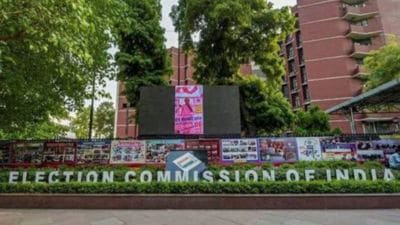IMD rain forecasts for Mumbai wrong by 42% in July. What explains these extreme misses?
Mumbai is home to two doppler weather radars, one of the most sophisticated instruments in modern meteorology. One of them, a S-band radar, sits atop IMD’s Colaba observatory and the other one, a C-band radar, is in Veravali.
 The IMD issues its daily forecast at 1 pm, for a 24-hour period starting 8.30 am that day to 8.30 am the following day. There are five-, two- and three-day advance forecasts as well, but the 24-hour forecasts are considered the most accurate.
The IMD issues its daily forecast at 1 pm, for a 24-hour period starting 8.30 am that day to 8.30 am the following day. There are five-, two- and three-day advance forecasts as well, but the 24-hour forecasts are considered the most accurate.WHEN Mumbai woke up on July 8, it was taken by surprise – large parts of the city were inundated in the 200 mm overnight rains. But nothing about the India Meteorological Department’s (IMD) prediction, issued the previous day, had prepared the city for the downpour. The agency had issued a yellow alert, which meant the city was expected to receive up to 115 mm of rainfall in 24 hours. But the metropolis ended up getting 267 mm rain in the period.
This wasn’t a rare miss by the IMD. Data reviewed by The Indian Express shows that the agency, despite being equipped with some of the most advanced instruments, issued inaccurate district forecasts for Mumbai on at least 13 days in July, of which, on eight days, the forecast warnings were off by more than 25 per cent.

On July 24-25, the rains caught Mumbai, and the IMD, unawares once again. This time, on July 24, the IMD had issued a
yellow alert (heavy rainfall, 64.5-115.5 mm) for the following day. But that day, July 25, going by the heavy rainfall in some parts, the IMD upgraded the alert for the day from yellow to red (extremely heavy, above 200 mm). But by then, the rains had receded.
The IMD issues its daily forecast at 1 pm, for a 24-hour period starting 8.30 am that day to 8.30 am the following day. There are five-, two- and three-day advance forecasts as well, but the 24-hour forecasts are considered the most accurate.

In a city where local trains — and therefore, lives — often come to halt during the monsoons, there have been demands that the forecasts be issued earlier in the day. In July, the IMD’s forecasts for the city were off nearly 42 per cent. Besides this, data showed that on at least four days in July, the IMD had changed its forecast and warnings twice within a 24-hour window.
Forecasting mechanism
Mumbai is home to two doppler weather radars, one of the most sophisticated instruments in modern meteorology. One of them, a S-band radar, sits atop IMD’s Colaba observatory and the other one, a C-band radar, is in Veravali. “Alongside tracking cyclones, radars are also very useful for tracking other weather developments like thunderstorm activities. For thunderstorms, the radars undertake scanning every 10 minutes. Through the regular scans, the radars help in providing localised forecasts depending on the cloud developments and other factors,” IMD Mumbai Director Sunil Kamble told The Indian Express. Together, the two radars are more than sufficient for Mumbai (603.4 km area), agreed weather scientists.

Unlike other districts, the metropolitan region of Mumbai is also home to the BMC’s over 140 automatic weather stations, besides the IMD’s own observatories at Santacruz and Colaba. Yet, as the data reflects, the weather bureau often fails to issue accurate and timely forecasts, leaving residents in a lurch.
IMD acknowledges that its forecasts, particularly the city-specific forecasts, have not been perfect, but says its accuracy levels are improving. “IMD’s forecasting systems have improved by 40-50 per cent in the last decade compared to previous years. But it needs to be understood that weather forecasting is a nonlinear science, which means that unlike other sciences, weather has greater unpredictability,” said Mrutyunjay Mohapatra, Director General of Meteorology.
In the last one decade, IMD has seen a significant increase in its observational network. It operates more than 400 weather stations, besides having over 1,000 automatic weather stations and 1,300 automatic rain gauges. That has enabled IMD to provide much better forecasts. But the weather systems have also become much more unpredictable in the last few years. This is particularly true of extreme weather events, exposing the inadequacies of the IMD.

According to Met scientists, IMD models often fail to capture extremely localised weather systems which bring extremely heavy rain within a short span of time, making them difficult to forecast. “That is what happened on the intermittent night of July 7 and 8. While there are about three to four types of weather systems which typically bring rain to Mumbai during monsoons, some small-scale systems, being very localised, are not easy to capture,” explained a senior IMD scientist.
“On July 7, there were no systems which ideally bring rain in the city, and the rain was a result of an off-shore vortex, which is a very localised system, and thus our models couldn’t capture it,” they added.
A senior scientist from IMD said that Mumbai’s proximity to seas and ghats makes the weather prone to dynamic changes, making forecasting even more challenging. Raghu Murtugudde, professor of climate studies at IIT Bombay, said: “What makes forecasting even more challenging in the tropics is that ocean and land temperatures as well as urban areas can amplify convection. Even irrigation and other activity can add to the rainfall processes because of warm temperatures, with warm air holding a lot of moisture. This moisture acts like a steroid for heavy rainfall.”
Meanwhile, on the question of the yellow alerts in Mumbai, despite only light rain, another IMD scientist said, “We issue the forecasts on the basis of the rainfall amount and impact, which means the rain in the past days and the probability. During monsoons, if we see a conducive weather system and see a likelihood of any rainfall, we issue the warnings as an SOP.”
‘Work in progress’
Mohapatra, the IMD head, said improving forecast accuracy was a continuing exercise. “Over the past years, we have strengthened our mechanisms. Since the weather forecast depends on the observational network, Mumbai and neighbouring areas have now been deployed with over 160 automatic weather systems which provide data every 15 minutes. We have also started issuing impact-based forecasts for five days, which tries to predict the likely impacts of a heavy rainfall event, for example,” he added.












